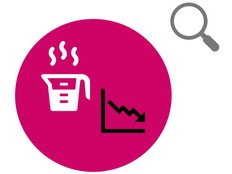Step 1: Prepare
What is it?
Investigate materials to see if they are transparent, translucent, or opaque using a torch and two BBC micro:bits.
This project is developed in partnership with White Rose Science for science teachers and allows students to explore the properties of materials and the effect of placing objects in the path of a beam of light. Students can also learn about using sequences, variables, and loops in a computer program.
This video explains how the project works and how to do the experiment.
How it works
- The same code is used on both micro:bits.
- One micro:bit is put into a box while another stays with you.
- You cover the open end of the box with the different materials you are testing and shine a torch through the materials into the box.
- The micro:bit in the box measures the light penetrating the material and sends its measurements by radio to the micro:bit in the room.
- The micro:bit in the room displays the light readings.
- Readings range from 0 (completely dark) to 100 (very bright). Lower readings suggest opacity and higher readings suggest transparency.
What you need
- a torch
- a long narrow box, paper cup, or cardboard tube with the lid removed
- materials to test such as a piece of paper, bubble wrap, felt, and a clear plastic sleeve, each big enough to cover the open end of the box
- two micro:bits
- at least one battery pack with new batteries
Step 2: Investigate
- Download the hex file and put the code onto both micro:bits. You do not need to write the code for this project yourself to do the experiment, but if you are interested in coding it, visit the Step 3: Code it section below.
- Attach a battery pack to at least one micro:bit. Put the micro:bit with the battery pack into the bottom of the box with the LEDs face up. Put the battery pack under the micro:bit so it doesn’t obscure the light.
- Turn on the torch and hold it at the opening of, but not inside, the box. Press button B on the micro:bit in the room to measure the light level at the bottom of the box. Note the reading. For accuracy, complete the test three times and work out the average. This is your control reading, which you should take as a reference, because your maximum light readings will depend on the strength of your torch.
- Now place a piece of the material you are testing over the end of the box. Shine the torch through the material, keeping it in the same position in relation to the box as before. Press button B again and note the reading.
- Repeat for other materials.
- Compare your results. Are they what you expected?
Tips
- You may like to conduct this investigation with someone else, as it can be difficult to hold the torch and material while taking readings.
- If you get any unexpected readings of 0 during the investigation, try disconnecting and reconnecting the battery packs or pressing the reset button on the back of the micro:bits.
- Some materials may let some light through that the micro:bit does not detect. Place the torch against the material sample to achieve the best results.
- Two-digit numbers will scroll across the micro:bit's LED display. Encourage students to practise reading numbers from the display before the experiment.
Doing this experiment in a class or coding club
If you are doing this experiment in a class or coding club, each pair of micro:bits should have different matching radio group numbers. This will ensure each receiver micro:bit receives the readings from the correct transmitter micro:bit.
Open the project in Microsoft MakeCode and enter a unique number in the radio set group block, then download that hex file onto two micro:bits. Keep them together with an elastic band or in a small bag. Repeat for each pair of micro:bits being used in the class.
Step 3: Code it
Watch this video to find out how to code the project:
If you are interested in modifying the code for this project, click on one of the buttons below:
This content is published under a Creative Commons Attribution-ShareAlike 4.0 International (CC BY-SA 4.0) licence.



